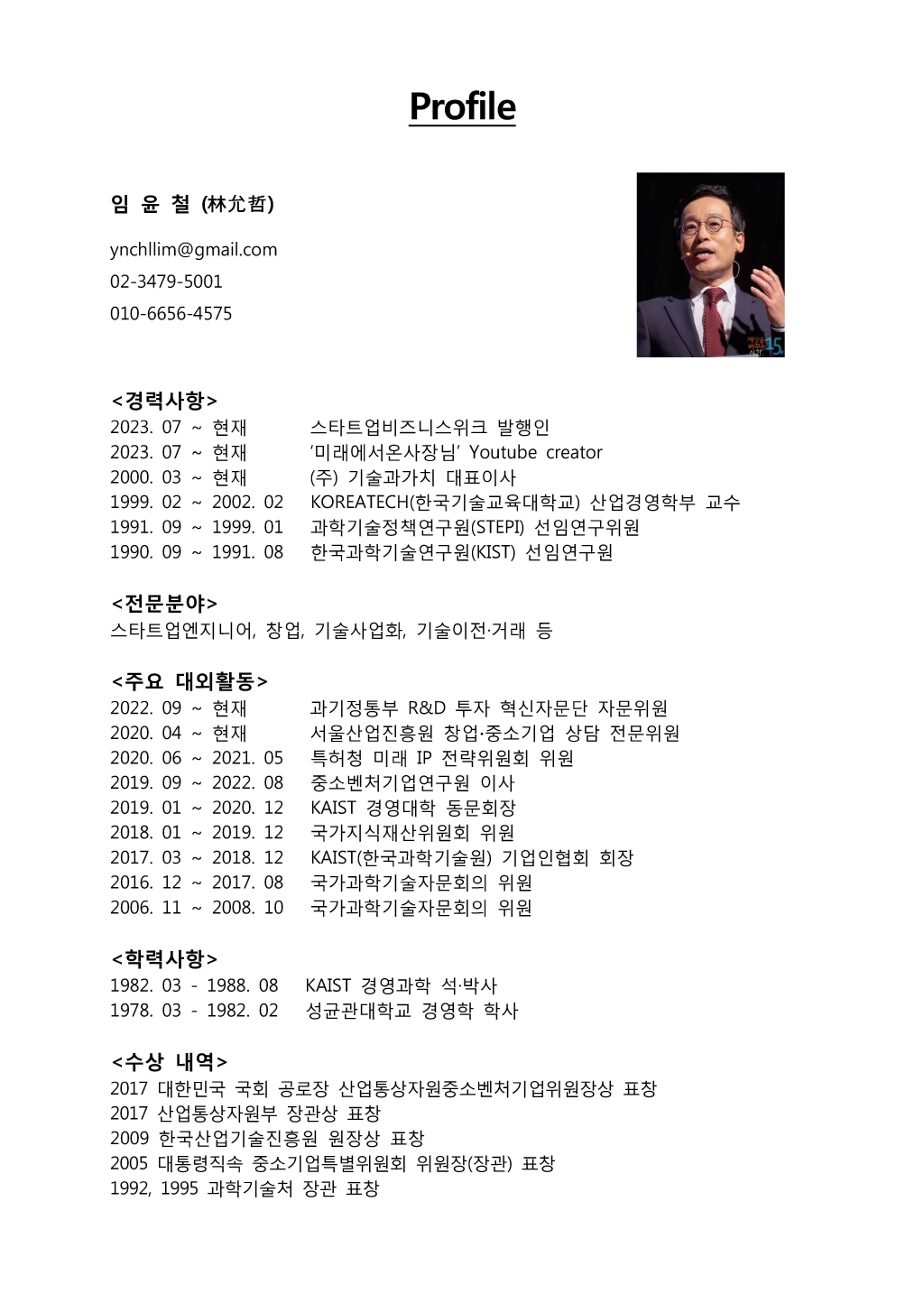


TECHNOVALUE
2022년 5월이지요, 새 정부가 들어서자 마자 바이든 미국대통령이 우리나라를 방문합니다. 그런데 보통은 영접받고 대통령 만나러 가는 것이 보통의 이야기인데, 입국하자마자 삼성전자를 먼저 방문하고 이재용회장을 만나고, 떠나는 날은 정의선회장과는 하이야트호텔에서 단독 비즈니스 회의를 합니다. 이제까지는 정치·경제라고 이야기하면서 정치가 앞서 있었는데, 이제는 경제·정치 아닌가? 이제는 국가경영에서 경제가 최우선이라는 생각이 듭니다.
우리네 일반인들의 하루 생활을 들여다보면 거의 하루종일 경제활동을 하느라 바쁩니다. 건강관련 기술은 비약적으로 발전하여 우리들 수명을 늘려주지만 반대로 다른 기술들은 우리들의 일자리 수명주기를 짧게 만들고 있습니다. 이제 직업은 없어졌습니다. 직장만 있습니다. 신문에 보니까 이제 평균 49세가 되면 정년이 된답니다. 인생 이모작 준비를 40대부터 해야하는 시대입니다. 누구나 새로운 일을 찾아야 합니다. 60대가 넘는 것은 기본이며 70세까지도 일을 해야 하는 경제환경이 되었고 이것이 뉴노멀이 되었습니다. 30·40·50·60이 모두 함께 일하는 새로운 경제환경으로 전환이 되고 있습니다.
이것을 가능하게 만들어주는 매개체가 ‘스타트업(STARTUP)’입니다. ‘스타트업을 직접하던지, 아니면 스타트업과 함께 일을 하면 됩니다. 함께 일한다는 것은 미생인 스타트업을 완생으로 만들어가는데 동참하면 됩니다. 스타트업은 30·40의 전유물이 아닙니다. 50·60도 스타트업을 알아야 합니다. 전문적인 Gig Woker가 되거나(저는 스타트업엔지니어라고 이름지었습니다) 경험을 가진 창업자가 되어서 유망한 스타트업도 만들 수 있습니다.
서재필선생께서 1896년에 우리나라의 최초 민간신문인 독립신문을 만들었습니다. “앞으로 새로운 세상이 펼쳐진다, 이를 우리말로 알리자”는 뜻으로. 저도 감히, 이 미디어 『StartupBusinessWeek』를 통해 이제 막 펼쳐지는 한국의 스타트업경제를 전 세계에 알리고, 유니콘기업으로 키울 수 있는 우리 주변의 ‘어린유니콘’ 싹(startup)을 세상에 알리고, 앞으로 100년 우리경제를 만들 스타트업경제 생태계를 함께 만들자고 외치고 싶습니다. 어마어마한 일이지만 『StartupBusinessWeek』라는 1인 미디어로 한 발걸음 시작하고자 합니다.
이 일은 제가 혼자할 수 없습니다. ‘아이하나 키우는데 마을주민 모두가 필요하다’는 아프리카 속담처럼 우리나라의 스타트업경제를 만들려면 우리사회의 모든 분야의 많은 전문가 분들이 도와주시고 적극 참여해주셔야 합니다. 우리 사회가 지금 해야 할 일도 이 미디어에 담아서 요청드리고자 합니다. 진심으로 진심으로 많은 관심과 지원을 부탁드립니다.
StartupBusinessWeek.com
발행인 배상

2023년11월5일
스타트업 생태계가 완성이 되려면 일단, 생태계를 구성하는 경제주체들이 하나 둘씩 만들어져야 한다. 첫째 경제주체는 스타트업이다. 스타트업을 하겠다는 기업가정신이 충만한 이들이 사회에서 공급됭야 하고 이들이 스타트업을 창업하고 경영활동을 시작해야한다. 1999년, 2000년 경의 벤처 붐을 보면 지금의 상황과 똑같지는 않지만 그때부터 이런 스타트업들이 만들어지기 시작했다. 그리고 이들은 창업초기는 물론 성장하면서 자본을 유입해야 하는데, 이 자본가의 역할을 지금의 벤처캐피탈이라는 경제주체가 자리매김을 했다. 생태계의 중요한 두 개의 경제주체가 만들어진 것으로 보인다.
지금의 생태계가 활성화되려면 정부의 역할도 필요하다. 정부는 초기자본의 유입에 마중물 역할을 해야 하고, 스타트업이 IPO나 M&A가 용이하도록 관련된 법과 제도를 필요한 만큼 빨리 수정해주는 것이 필요하다. 스타트업들이 만든 기업가치가 사회에서 사고 팔리는 과정을 기획하고 정착이 되도록 하는 역할을 담당해야 한다. 스타트업들이 성장해가는 영역은 민간의 다양한 전문기업이나 전문가들 영역으로 이들이 스타트업엔지니어로서 경제활동을 잘 할 수 있도록 경제주체들간의 거래를 통해 자리매김을 해 나가야 한다.
생태계에서의 공급과 수요가 서로 균형있게 성장해야 한다. 좋은 스타트업이 많이 출현해야 하고 자본이 공급되어야 하고 경영에 성공하는 스타트업들이 나타나서 EXIT을 해야 하는 등의 활동이 이어질 때, 선순환구조의 틀이 완성이 된다. 스타트업으로 돈을 벌 수 있다면 금융은 저절로 따라 들어오기 때문에 결국은 좋은 스타트업들이 만들어지는 것이 생태계 활성활성화에 첫 번째 관문이다. 어떻게 하면 좋은 스타트업이 많아질까? 이에 대한 답은 우리 사회가 관심을 갖아야 한다.
스타트업을 창업한다고 생각하면 제일 먼저 생각나는 것이 무엇일까? 창업에 대한 두려움이다. 우리는 다른 사람들의 눈을 생각한다. 다른 사람이 나를 어떻게 볼 것인지에 대한 생각을 항상 염두해 둔다. 하나의 사회를 만들어 가는 중요한 요인인데, 스타트업경제 생태계를 활성화 시키기 위해서는 ‘너무 다른 이들을 의식하지 않았으면 좋겠다’ 는 식의 사고가 필요하다. 창업에 대한 두려움은 창업을 했다가 잘 안되면, 다른 사람이 실패라고 여길 때, 나에 대한 부정적인 평가를 두려워한다. 충분히 이해는 되지만 이 생각의 공식을 사회가 바꿔준다면 더 좋은 기업가 정신의 사람들이 생태계에 들어 올 것이다.
성공과 실패의 단어는 붙어 다닌다, 반대말로 붙어 다닌다. 실패는 성공의 반대말이 아니고, 실패는 성공의 과정으로 인지되도록 우리 사회가 리드해주어야 한다. 이시대의 기업가정신 키워드는 바로 “실패는 성공의 과정이지 반대말이 아니다” 이다. 이는 에디슨도 그랬고, 헨리포드도 그랬고, 잭웰치도 그랬고, 빌게이츠도 그랬고, 스티브잡스, 제프베조스, 일론머스크, 마크저커버거 들을 기억하면 된다. 스타트업비지니스위크의 슬로건은 “실패는 성공의 과정이다, 반대말이 아니다” 이다.
1) STRAT UP은, 누구나 가능하지만, 아무나 해서는 안되고,
2) 언제나 시작할 수 있지만, 준비한 뒤에 시작해야 하고,
3) 어떤 주제로도 할 수 있지만, 세상이 관심 갖는 주제가 좋고,
4) 나를 부자 만들기 전에, 투자자를 먼저 부자로 만들어 주고,
5) 육상 달리기라고 생각하지 말고, 농구라고 생각해야 하고,
6) 기업가치 보다는 BEP(손익분기점)에 빨리 도달해야 하고,
7) 법이 있으면 지키고, 없으면 유리한 법을 만들어야 하고,
8) 앞으로는 IPO를 외치고, 뒤로는 M&A EXIT을 생각하고,
9) 죽기 살기로 해야 하지만 ‘중꺾마’를 잊지 말고,
10) 돈흐름을 보고, STAY HUNGRY, STAY FOOLISH를 !!!!!











2012-11-22 10:19:00

농수산물을 장기간 싱싱하게 보관하는 기술이 있다면? 수확한 과일을 저장해놨다가 값이 가장 높을 때 출하할 수 있고, 꽃은 비행기보다 저렴한 선박에 실어 수출할 수 있게 된다. 무선 충전 기술이 상용화된다면? 우리는 카페나 식당에 들어가기만 해도 휴대전화나 노트북이 자동으로 충전되는 세상에 살게 될 것이다.
‘기술과가치’가 요즘 사업화에 주력하는 기술 중 일부다. 이 회사는 올해 3월 지식경제부가 지정한 7개 사업화전문회사 중 하나로, 공공이나 민간이 개발한 기술이 실제 비즈니스로 자리 잡기까지 시장조사 및 분석, 전략 컨설팅 등을 제공한다. 임윤철 대표는 “좋은 기술이란 곧 사용처가 많은 기술”이라며 “이들 기술로 제품을 만들기에 앞서 국내외에 특허 등록해 글로벌화 발판을 다지는 데 주력하고 있다”고 말했다.
20여년간 과학기술 정책 및 지식산업 전반을 연구해온 임 대표는 우리나라 중소·벤처기업이 ‘강소기업’이 되기 위해 참고해야 할 대상으로 미국 애플사(社)를 꼽았다. 제조는 남에게 맡기고 기획과 개발에만 집중함으로써 고부가가치를 낸다는 점에서다.
“지식산업에서 승리하려면 몸집이 가벼워야 합니다. 제조는 제조 전문회사에 맡기고 아이디어와 기술로 무장해야 해요. 패스트 팔로어(fast follower) 전략으로 성장해온 우리나라는 여전히 중소기업을 제조 능력 기준으로 판단해 안타깝습니다. 이제 퍼스트 무버(first mover)만 살아남는다는 논리엔 재고의 여지가 없습니다. ‘made by’가 아니라 ‘designed by’‘innovated by’가 지식산업의 핵심임을 기억해야 합니다.”
어떻게 아이디어를 고안하고 기술을 접목해 혁신을 이끌어낼까. 사실 누구나 이 대목에서 고민이 많다. 이에 기술과가치는 내년부터 ‘3000/ 5000 프로젝트’라는 교육 사업을 전개하기로 했다. 3000개 중소기업 및 연구기관의 5000명 핵심 인재를 대상으로 애플처럼 혁신을 이루기 위해 무엇을 해야 하는지 감(感)을 익히게 하는 게 목표다. 그래서 방법론보다는 역사, 철학, 과학기술과 사회 등 인문학과 과학기술을 융합한 커리큘럼을 개발하고 있다. 임 대표는 “필연적으로 혹은 우연하게 개발된 수많은 기술 중 사회가 필요로 하는 것만 빛을 보게 된다”며 “인간, 역사, 사회 등을 이해해야 하는 이유가 여기에 있다”고 말했다.
임 대표는 국가과학기술자문위원회 위원 등을 역임하며 여러 차례 정부 과학기술 정책에 참여한 바 있다. 유력 대선주자 모두가 과학기술 전담 부처 신설을 공약으로 내세운 것에 대해 그는 “우리 산업이 퍼스트 무버로 거듭나는 데 정부가 어떤 도움을 줄 수 있는지 고민하는 게 먼저라고 생각한다”고 밝혔다.
입력2006.04.08 16:34 수정2006.04.08 20:10
지난주 4일 동안 미국에서 열린 기술이전,기술사업화 관련 AUTM 컨퍼런스에 참석했다. 1500여명이 참가했는데 대부분 미주 지역 회원들이었지만 우리나라와 일본 대만 싱가포르를 비롯한 아시아 전문가들도 많이 보였다. 이들이 오래 전부터 이런 모임을 만들고 머리를 맞대어 고민하는 내용은 '공공기술(정부투자 연구개발의 결과물인 기술)을 어떻게 하면 산업체에서 많이 사업화되도록 할 수 있을 것인가'에 대한 것이다. 우리나라 정부 연구개발비의 절대규모는 선진국과 비교해 아직 크게 부족하지만 상대규모는 이미 세계적인 수준이다. 이는 미래의 국가경쟁력과 국민의 삶의 질을 높이기 위한 매우 큰 투자가 아닐 수 없다. 시스템에 투입이 많으면 당연히 많은 결과를 기대한다. 따라서 5년,10년 뒤에 어떤 결과를 얻게 될 것인지가 매우 궁금해진다. "우리나라 정부연구개발비의 투자수익률은 과연 얼마나 될까?" 연구개발 투자에 대한 수익률 계산은 매우 어렵다. 장기간의 시간을 기다려야 투자 결과를 알 수 있고,개별 연구개발 투자가 개개의 성과를 만들어내지 않는 경우도 많으며,의외로 기대하지 않았던 파생적인 결과가 좋은 투자성과를 만들어 내기도 하기 때문이다. 또 연구개발 과정에서 나온 모든 결과를 수익관점의 지표로 만들기 어려운 이유도 있다. 정부연구개발비 투자수익률 계산을 위해서는 수식에 많은 가정이 동원되겠지만,이 투자수익률은 반드시 계산돼야 한다. 매년 확인해 보고 증감의 원인을 분석하며 필요한 대책을 마련해야 한다. 그래야 국가기술혁신시스템이 업그레이드되고 다른 패러다임으로 바꾸는 기회를 만들어 갈 수 있기 때문이다. 정부가 추진하고 있는 성과관리프로그램과 연계를 통해 모델을 만들어야 할 것이다. 다음으로 어떻게 하면 정부연구개발비 투자 수익률을 높일 수 있을까? 첫째 많은 연구개발비로 아무리 열심히 연구개발 활동을 한다 해도 초기부터 사업화 목표가 분명하지 않으면 좋은 결과를 기대하기 어렵다. 둘째 사업화 연구개발은 연구자들로만 구성해 추진하기보다는 초기부터 사업화 전문가들과 공동팀으로 추진하되,연구자들이 주어진 연구에만 전념할 수 있는 환경을 배려해야 한다. 셋째 사업화 연구개발은 목표시장의 변화에 유연하게 대응할 수 있어야 한다. 즉 연구개발 과정에서 투자의 확대,축소,공동연구 추진 등의 판단 및 선택을 책임자 주관 하에 가능하도록 해야 한다. 마지막으로 사업화 성공률을 높이기 위해서는 연구개발비 이외의 항목으로 관련 제비용에 자원 배분이 필요하다. 이러한 점들을 반영하는 정부연구개발사업의 전반적 구조개선이 있어야 정부연구개발비 투자 수익률을 제고할 수 있는 기반이 마련될 것 같다.
입력2006.04.08 16:20 수정2006.04.08 20:03
박지성과 이영표 선수 덕분에 프리미어리그 축구 몇 경기를 재미있게 감상하고 나서, "이 축구리그는 어떻게 그런 경쟁력을 유지하는 것일까?"를 생각해 보았다. 우선 프리미어리그의 20개 축구팀은 모두 세계적 수준이다. 팀마다 공 다루는 선수 개인역량은 뛰어났고,체력은 지칠 줄 모른다. 골대 가까이 가면서 동료선수들과 협력하며 공을 주고 받는 능력은 감탄하지 않을 수 없다. 세계적 선수를 발굴하고 경기전략을 수립하면서 팀을 총 지휘하는 감독,체계적 팀 연습을 주관하는 코치,경기 내용과 선수들의 움직임 몸상태를 기록하고 분석하는 전문가 등 과학적 축구팀 경영방식이 이 리그의 경쟁력을 높이고 있다. 최종 성적 기준으로 시즌이 끝나면 20개 중 하위3개 팀은 차하위 리그로 무조건 강등된다. 그리고 차하위 리그의 3팀이 승격된다. 단순한 운영방법을 엄격하게 적용하는 것이 리그 경쟁력을 높이고 있다. 관중도 한 역할을 한다. 관중들은 선수들의 훌륭한 플레이에 진정한 박수를 보내고,자기들이 후원하는 축구팀을 사랑한다. 하지만 한편으로 이들은 개별 축구팀의 선수 감독 코치를 엄격하게 평가하고 있다. 세계적 수준의 축구팀,과학적 경영방식,엄격한 리그 운영제도,관객의 객관적인 평가역할이 프리미어리그의 경쟁력을 만들고 있다. 부족하지만 이 교훈을 통해 우리나라 기술혁신시스템 업그레이드 방법을 생각해 본다. 우선 기술혁신시스템 안에 기술집약형 기업과 세계적인 연구집단이 지금보다 많아야 겠다. 특히 출연(연)과 대학,기업은 보다 적극적으로 상호 협력해야 기술혁신을 많이 만들어 낼 것이다. 기술집약형 기업들은 새로운 기업경영방식을 채택해야 한다. 기존제품 개선 위주의 기술개발 능력도 필요하지만,세계 최초의 제품과 서비스를 만들어 낼 수 있는 기술개발 능력을 키워야 한다. 이를 기반으로 세계 시장을 개척하는 마케팅 능력도 키워야 한다. 정부는 기술혁신 과정에서 필요한 공공부문의 역할을 재정의해서 정책·제도를 단순화할 필요가 있다. 정부지원이 필요한 금융투자 영역은 확대를,백화점 나열식의 중복 서비스 영역은 민간 이관이 필요하다. 또 정부는 하드웨어 투자중심에서 기술혁신 과정에 필요한 소프트웨어 투자중심으로 전환되어야 한다. 기술혁신은 기업이 중심이 되고,경제적 인센티브 메커니즘이 작동되어야 가속화되기 때문이다. 마지막으로 우리 국민들도 새로운 기술혁신형 경제체제를 폭넓게 이해해주고,지지를 해주어야 할 것 같다, 새로운 시스템에서 뛸 기업,출연(연),대학에 대한 사랑과 관심이 필요하고 이들의 성과와 정부 정책에 대해 새로운 기준으로 평가를 해야 하기 때문이다.
입력2006.04.08 16:41 수정2006.04.08 20:15
바쁜 일정과 많은 연락처의 전화번호를 함께 저장하려고 PDA를 사용하기 시작한 지 2년이 조금 넘었다. 뒷주머니에는 휴대폰을,안주머니에는 PDA를 동시에 넣고 다니다가 지금은 휴대폰과 PDA 기능이 함께 있는 PDA폰을 구입해서 사용하고 있다. 최근에 얇은 휴대폰 모델을 보니까,두껍고 투박한 PDA폰이 불편해지기 시작했는데 때마침 DMB 방송 때문에 단말기 보조금 지급 행사가 시작된다니 유혹은 점점 더 커진다. 휴대폰 단말기 구입시에 보조금을 지급하는 행사는 그 단말기 판매를 늘려준다. 이는 첨단 기술 제품의 수요를 진작해주는 정책의 일환으로,해당 휴대폰 단말기의 제품경쟁력을 높여주며 장기적으로 휴대폰 단말기를 생산하는 기업의 경쟁력 제고에 긍정적 영향을 미칠 것이다. 이와 같은 정부의 시장수요정책은 매우 중요하다. 글로벌 경제전쟁이 가속화되면서 세계 각국은 고부가가치형 기술혁신 기업을 많이 보유하기 위해 부단한 노력을 하고 있다. 이러한 기업들이 많아야 나라가 부자가 되기 때문이다. 이들을 많이 만들려면 정부는 균형적인 기술혁신정책을 수립하고 이를 체계적으로 추진해야 한다. 균형적인 기술혁신정책이란 말 그대로 기술공급정책과 시장수요정책이 균형을 이뤄야 한다는 것이다. 현재 우리나라가 기술혁신 기업 수를 늘리기 위해 취하고 있는 정책을 이 두 가지로 나눠보면 어떻게 되어 있을까? 과연 두 가지 정책이 균형을 이루고 있을까? 여기에 대한 분석을 한 연구를 찾아보지는 못했지만,15년 동안 이 분야 현장에서 일한 경험으로 보면 아마도 기술공급정책이 훨씬 많을 것으로 생각한다. 왜냐하면 이는 상대적으로 책상에 앉아 쉽게 생각해낼 수 있는 정책이고,1년에 한 번 기획예산처에서 예산만 확보하면 추진할 수 있는 것이기 때문이다. 또 정책이 만들어진 후에는 그 효과에 대해 제대로 된 평가를 하지 않는 것이 현재의 상황이기 때문이다. 게다가 기존 정책의 완성도를 높이려는 노력보다는 무언가 새로운 정책을 개발하는 것이 성과로 집계되는 현실에서는 기술공급정책이 많아질 수밖에 없다. 기술혁신 기업을 많이 만들기 위해서는 시장수요정책에 더욱 관심을 가져야 한다. 그래야 기업들이 제품을 잘 기획하고,생산능력을 키우고,마케팅 능력을 키울 수 있기 때문이다. 우리나라 현실에 맞는 여러 아이디어를 찾아야 한다. 이마이 겐이치의 말대로 국가 간 시스템경쟁이 한창이다. 국가기술 혁신시스템의 완성도를 높이기 위해 각종 기술공급정책을 통합 조정하고,시장수요정책을 보다 많이 개발해서 균형을 만들려는 부단한 노력이 절실히 요구된다.
입력2006.04.08 16:47 수정2006.04.08 20:19
최근 양극화에 대한 문제가 신문 지면을 많이 장식하고 이의 해결에 대한 의견도 자주 등장한다. 주로 부자들이 세금을 많이 내고,이 세금으로 양극화를 해소하자는 의견이 많은 것 같다. 물론 단기적으로는 이러한 방법이 필요할지 모르지만 장기적으로는 양극화가 깊어지는 것을 근본적으로 막는 다른 방법을 찾아야 한다고 생각한다. 학생 시절 따라부르던 노래 중 의미 깊은 것 하나가 생각난다. '깊은 산 오솔길 옆 자그마한 연못에 예쁜 붕어 두 마리 살고 있다가,둘이 싸워 한 마리가 물 위에 떠올라 어린 살이 썩어 들어가 물도 따라 썩어 들어가,연못 속에는 아무 것도 살 수 없게 되었다'는 노랫말이다. 이 노래를 들으면 우선 '우리''공동체''사회'라는 개념을 다시 한번 생각해 보게 된다. 특히 '같이' 생활하고 '같이' 만들어 가는 사회를 생각하게 된다. 나 대신 다른 역할을 해주는 구성원들이 있기에 내가 존재할 수 있다는 것을 깨닫는다. 술자리에서만 '우리가 남이가?'를 외칠 것이 아니라 다른 역할을 하는 주체를 인정하고 우리는 항상 공동체임을 잊지 말아야 한다. 그래야만 항상 나오는 '대기업-중소기업 상생 방법을 찾는다'는 얘기가 겉치레가 되지 않을 것이다. 또 하나는 우리 경제의 강자들이 골목대장에서 벗어나야 한다. 그동안 우리 정부는 압축 성장 전략을 통해 경제의 강자를 만들어 주었다. 이들 강자는 혜택을 보았으면서도 여전히 골목대장 노릇만 하고 골목 약자들에게 얼차려를 시키고 심지어는 코묻은 돈(?)까지도 빼앗아 가 버린다. 지난 2년 동안 연말의 신문을 크게 장식한 뉴스가 있었다. 우리나라 굴지의 대기업의 당기순이익이 사상 최대였다는 기사다. 같은 기간 하청 중소기업들의 성적도 그만큼 동시에 좋아졌을까? 많은 하청 중소기업이 가져야 할 성과를 이들이 얼마나 빼앗았을까 생각해 보니 씁쓸한 웃음만 짓게 된다. 한편 약자들은 강자들에게 지금의 상황을 개선해 새로운 차원의 균형을 만들겠다는 의지를 가지고 이를 개척해야 한다. 그 중 한 가지 방법으로 작아도 강한 글로벌 기업이 되도록 노력해야 한다. 약자는 이를 위해 정부에 지원을 요구해야 한다. 국내 대기업에 대한 납품만을 생각하지 말고 세계시장을 개척하는 노력을 더욱 열심히 해서 세계경쟁력을 만드는 일이 중요하다. 우리나라 혁신시스템에서 양극화가 지속된다면 국가적 발전을 기대하기는 어렵다. 지금처럼 우리 대기업들이 국내에서 대장 노릇만 즐기고 기술집약적 중소기업을 키우겠다는 생각을 하지 않는다면 우리 중소기업 생태계는 조만간 황폐해질 것이고 장기적으로는 점차 대기업도 성장동력을 찾는 데 실패해 공멸을 자초할 것이기 때문이다.
입력2006.04.26. 오후 5:39
최근 베트남 산업부 고위 공직자와 대학교 총장,학장 일행을 맞아 우리나라 직업훈련시스템을 설명하고 벤처기업의 베트남 진출 현안을 논의하는 자리가 있었다. 짧은 일정임에도 불구,우리의 다양한 시스템을 배워보려는 그들의 노력은 매우 인상적이었다.
한편 미국 회사와 회의를 준비하는 과정,회의를 마친 뒤 후속 업무를 추진하는 과정,결정된 과업을 일정별로 각자 완수하는 과정 등을 통해 우리는 이들의 업무 생산성이 매우 높고 프로페셔널하다는 느낌을 받지 않을 수 없었다. 거북이는 쉬지 않고 경주를 하는 반면 토끼는 잠을 자다가 거북이에게 진다는 이야기,놀기 좋아하던 베짱이가 겨울 준비를 하지 않아 개미에게 신세를 진다는 이야기를 우리는 잘 알고 있다.
지금 우리와 경쟁하는 주변 국을 둘러보자.잠자는 토끼도 없고,노는 베짱이도 없다.
그동안 우리는 기술혁신 노력을 열심히 해왔다. 그리고 상당한 성과를 보기도 했다. 하지만 향후 국가 전체의 기술혁신을 가속화하기 위해 꼭 강조하고 싶은 점이 있다. 우선 기술혁신을 위해서 국가 차원의 의사결정 시스템 변화를 강조하고 싶다. 잘 알고 있듯이 이제는 몸집이 큰 조직보다는 빠른 조직이 경쟁에서 이긴다. 조직의 신속한 의사결정과 이에 따른 자원 배분이 가능하기 때문이다. 우리나라의 기술혁신은 정부가 기획하고 있으며,필요한 예산은 1년에 한 번씩 결정하고 있다. 따라서 예산 편성 기간 이후에 새로운 프로그램 아이디어가 나와도 이를 실행에 옮기려면 2년을 기다려야 한다. 국가 간 경제전쟁의 양상이 시간경쟁으로 들어간 지 오래됐는데 이를 지원하는 시스템에는 변화가 없다. 또 우리는 통제가능성,관리의 투명성과 안정성 때문에 다양한 기술혁신 프로그램을 유연성과 신속성이 부족한 공공기관에서 주관하도록 하고 있다. 하지만 기술혁신의 역동성과 이윤추구 가능성 측면에서 보자면 민간이 프로그램을 주관하는 것이 더 효과적인 경우도 많이 찾을 수 있다. 형식보다는 실제 국가 차원에서 기술혁신 성과를 높이는 방법을 생각하고 결정하는 것이 필요하다. 한편으로는 지방정부도 제 역할을 해야 한다. 중앙정부는 전국의 모든 기업에 공평한 입장이 되어야 하지만 지방정부는 자기 지역 기업들이 고용 창출을 많이 하도록 적극 지원하는 입장이기 때문이다. 국가의 기술혁신에서 중앙정부와 지방정부의 역할 분담에 대한 논의가 필요하고,중앙정부가 확보한 예산 중 일부는 지방정부가 집행할 수 있는 방법을 함께 마련하는 것이 바람직할 것으로 보인다. 끝으로 기술로드맵도 중요하지만 이보다 앞서 기술혁신정책 로드맵을 만들어 체계적인 접근을 시도하는 것이 중요하다.
입력2006.04.19. 오후 6:10
우리는 지난 40여년간 고속 경제성장을 이뤘고,이는 정부가 적절한 정책을 잘 추진한 것이 큰 성공요인이었다는 것을 잘 알고 있다.
사실 정부가 정책을 개발함에 있어 과거와 현재를 비교하면 과거가 상대적으로 훨씬 쉬웠다. 왜냐하면 과거에는 워낙 되어 있는 것이 없었으니까,무엇이든 정부가 정책으로 추진할 수 있었다. 그러나 이제는 상황이 바뀌어 새로운 정책을 개발하기가 여간 어렵지 않다.
이런저런 정책을 모두 실행해 보았기 때문이다. 정부가 바뀔 때마다 국가차원의 새로운 목표는 계속 제시되고,공무원들은 이를 달성하기 위해 정책을 꾸준히 생산해야 하는 입장이다. 예전에 3년 동안 300억원을 사용한 정부 연구과제 책임자가 연구시작 시점에 연구기획을 거의 하지 않았다고 하면서,그래서 연구결과도 좋지 않다고 말한 적이 있다. 황당해서 맥이 빠지기도 하지만 3년이라는 연구기간을 성과 없이 보냈다면 결국 동일 기술분야에서 다른 나라와의 격차를 줄이기는커녕 더 넓혀 놓았다는 것 아닌가. 이러한 막대한 국가적 손실은 어떻게 계산할 수 있겠는가. 이는 프로그램 기획에 충분히 고민하지 않았기 때문일 것이다. 새로운 기술혁신정책을 개발하기 위해 필요한 몇 가지를 짚어보고 싶다. 기술혁신의 과정은 복잡하고 복합적이다. 따라서 정부가 새로운 기술정책 프로그램을 발굴하려면 충분한 기획 과정을 거쳐야만 한다. 그것도 객관적인 주체의 기획과정이 필요하다. 각 부처 간에는 이미 100여가지가 넘는 기술혁신 관련 지원 프로그램이 개발돼 있는 것으로 알려져 있다. 그러나 각 프로그램이 어떤 성과를 내는지는 정확히 파악되지 않고,부처 간 유사한 정책프로그램이 중복되고 있는 것 같다. 중복으로 인해 발생되는 예산낭비를 모두다 우려는 하고 있지만 특별한 해결방안은 찾지 못하고 있는 것 같다.
예산 낭비를 줄이려고 정부 연구과제를 수행하는 대학 교수들과 출연연구원 연구원들의 부적절한 연구비 사용을 막기 위해 공공부문 인력을 늘리는 것도 필요하겠지만,기술혁신 정책과 관련 프로그램 전반에 대한 철저한 분석을 통해 프로그램 통폐합이 우선적으로 필요하다.
새로운 정책을 만들기 위해서는 현실의 상황을 잘 파악할 수 있는 데이터가 있어야 한다.
현재 우리는 새로운 정책개발,혹은 프로그램 개발을 위해 어떤 데이터를 가지고 있는가? 먼저 객관적이고 충실한 데이터가 만들어져야만 정확한 정보를 얻을 수 있고,이 정보를 통해 기존 프로그램 실효성에 대한 판단을 할 수 있다. 또 새로운 프로그램의 기대결과에 대해 시뮬레이션도 가능한 것이다. 콩을 심어야 콩을 수확할 수 있다는 점을 깊이 새기고 싶다.
입력2006.04.12. 오후 5:33
따스한 봄날이 성큼 다가와 남산의 개나리와 철쭉을 보는 즐거움을 누리려 하는데,인상을 찌푸리게 하는 일들이 연일 신문을 장식한다.
자동차 대기업의 비정상적인 경영과 기업총수에 대한 뉴스가 그것이다. 연초에는 세계적 대기업인 재벌기업이 가히 천문학적인 금액을 사회에 내놓았다. 두 기업이 언론에서 주목받는 공통점은 모두 2세에게 경영권을 넘기는 과정에서 사용한 방법이 문제가 된 것으로 알려지고 있다. 그런데 우리는 이들을 글로벌 기업이라 부르고 있다. 두 기업은 우리 사회가 지난 30여년 동안 같이 만든 회사들이며,우리 경제에 기여한 바가 매우 큰 회사들이다. 우리는 이 두 기업을 높게 평가한다. 하지만 최근의 일로 인해 존경받는 글로벌 기업 이미지가 어떻게 바뀌게 될지 우려되기도 한다.
우리 사회는 앞으로 10년,20년을 내다보고 과연 또 어떤 기업을 만들어야 할까? 규모가 작아도 세계시장을 상대로 활동하는 글로벌 기업을 많이 만들었으면 하는 바람이다. 하지만 어떻게 하면 이러한 기업을 만들 수 있을까? 우선은 기업의 인식 변화가 필요하다.
기업은 자신들이 만든 제품과 용역을 사회가 구매해주기 때문에 살아갈 수 있다. 구체적으로 기업은 고객에게 감사해야 하지만,다양한 고객이 사회를 구성하므로 이들을 생각해야 한다. 국내를 벗어나 세계를 생각하는 기업경영을 펼쳐야 글로벌 기업의 후보가 될 것이다.
한편으론 우리사회가 기업에 대해 따뜻한 마음을 가지고 대해주었으면 좋겠다. 기업은 우리사회에 일자리를 만들어 주고 새로운 경제적 부가가치를 만드는 주체라는 점을 크게 인식해 경쟁력 있는 기업은 계속 뻗어갈 수 있도록 다양한 배려를 해주는 분위기가 중요하다.
우리 사회가 일반적인 사회문제뿐 아니라 기업 문제에도 관심을 갖는 분위기 전환이 필요하다. 또한 기업 간 협조도 중요하다.
기업생태계가 잘 유지되려면 대기업-중소기업 간의 협력을 통해 상생이 강조되어야 한다. 서로의 거래에서 제 값으로 주고 받을 수 있도록 거래 관행이 정착되는 것이 매우 중요하다. 정부도 중소기업을 지원하는 현재의 단편적,소극적 프로그램을 장기적 종합적 적극적인 프로그램으로 개편해 지속적인 투자노력이 있어야 겠다. 무엇이 필요한지를 다시 정의해보고 새로운 정책개발에 앞장서야 한다.
글로벌 기업은 단기간에 만들어질 수 없다. 최소한 10년,20년,아마도 30여년을 거쳐야 만들어질 수 있을 것이다. 장기적인 안목으로 존경받을 수 있는 글로벌기업을 우리가 많이 만드는 운동이라도 벌여야 할 시점인 것 같다.
입력2006.04.05. 오후 5:31
주 5일제를 하면서 양복을 안 입는 날이 자연히 많아졌다. 양복을 안 입으면 왠지 마음도 편해지고,새로운 아이디어도 더 많이 떠오르는 것 같다. 입고 있는 옷에 따라 사람의 생각과 행동이 많은 영향을 받는다는 것은 사실인 모양이다. 학생시절 교복을 입던 때,군대에서 군기 꽉 잡힌 군복을 입었던 시절을 생각하면 쉽게 이해가 간다. 그만큼 형식이 우리의 사고 틀에 크게 영향을 미치고 있다는 의미일 것이다. 따라서 새로운 사고와 행동이 필요하다면 과감히 다른 옷을 입는 것도 필요할 듯하다.
기술혁신은 연구개발 과정과 기술사업화 과정,두 가지가 모두 성공적인 결과를 내어야만 이루어 질 수 있다. 즉,연구개발을 통해 기술을 생산하는 과정과 이것으로 제품을 만들고 시장에 파는 과정이 모두 잘 이루어져야 성공적인 기술혁신이 된다. 기술혁신의 종류에 따라 다르겠지만 일반적으로 성공적인 기술혁신에서 기술의 기여도를 20% 정도라고 생각하면 기술사업화 과정의 기여도는 80%가 된다.
정부는 지난 30여년간 연구개발 과정에 집중 노력하였다. 과학기술분야의 9조원 가까운 정부예산 대부분이 이 과정에 투입되고 있다. 대단한 노력이 아닐 수 없으며,이러한 정부의 노력에 많은 박수를 보내야 한다. 하지만 아쉬운 점도 많이 보인다. 언제부터인지 정부는 연구개발 과정을 주관하면서 연구개발 효과성 제고라는 실리추구보다는,감사원 지적을 받지 않기 위한 절차와 명분,형식에 치우치는 것처럼 보인다. 소수 전문가들이 책임지는 의사결정보다는 공동책임 형식의 의사결정에 의존하고,연구과제선정 시 산업·제품 전문가보다는 이해관계가 없는 전문가 중심의 위원회를 구성 운영하는 경향이 있으며,선택과 집중보다는 형평이라는 목소리에 귀 기울이면서 작은 예산규모를 여럿에게 나눠주는 방식을 택하는 것처럼 보인다.
이제부터 정부는 기술사업화 과정에 더 많은 투자를 해야 한다. 여기서 주목할 것은 이 과정에 필요한 활동들은 기술마케팅,기술이전,기술금융,생산화,제품마케팅 등으로 연구개발활동과는 다른 성격이라는 것이다.
정부가 이 활동들을 지원하는 프로그램을 기획할 때 연구개발 과정에 적용된 '형식'을 생각하면 곤란하다는 것이다. 기술사업화 과정에 참여하는 주체가 연구개발 과정에 참여했던 주체가 아니라는 점과 이 과정에 소요되는 활동들이 연구개발활동과는 아주 다르다는 점을 인식해야 할 것이다. 시장의 논리를 이해하고 이를 잘 수행할 주체들에게 적합한 프로그램이 만들어져야 한다. 공공조직이 기술사업화의 활동을 하는 것보다는 경제적 인센티브로 활발히 활동하는 기업조직이 이를 담당하도록 해야 한다.
실리를 위해서 새로운 형식의 옷이 필요하고,발상의 전환이 필요하다.
입력2006.04.08 16:28 수정2006.04.08 20:06
올해 초 '우리나라는 2050년에 미국 다음으로 세계 2위의 1인당 국민소득을 달성하고,금액은 8만달러 이상이 된다'는 보고서를 읽었다. 먼 후일의 이야기라서 실감은 나지 않았으나 정말 그리 되어봤으면 싶었다. 그러나 현실은 어떠한가? 안타깝지만 1인당 국민소득은 10년째 2만달러 벽을 넘지 못하고 있다. 어떻게 하면 우리가 경제성장을 가속화해서 마(魔)의 2만달러 벽을 넘을 것인가. 우리보다 먼저 국민소득 2만달러 고지에 진입한 22개 국가는 과연 어떤 국가 전략을 사용했을까? 우리가 선택할 수 있는 전략 중 하나는 국가시스템 안에 기술혁신형 기업의 수를 배가시키는 것이다. 지금까지 많은 기업들이 저렴한 노동 경쟁력,단순 제조기술 경쟁력 등을 기반으로 성장해온 것과는 달리 이들 기업은 기술경쟁력을 바탕으로 세계시장을 직접 개척하는 특징을 갖는다. 이들은 국가기술혁신시스템 안에서 정부연구개발 결과를 경제적 성과로 전환시킬 수 있는 기술사업화의 첨병들이다. 그러면 과연 우리나라는 이들 기술혁신형 기업을 얼마나 잘 육성하고 있을까. 두 가지 측면의 제안을 해본다. 첫째,'율곡이이 선생의 10만 양병설'을 인용하여 감히 '기술혁신 사업가(Entrepreneur) 1만명 육성'을 주장해 본다. 왜냐하면 기술혁신 사업가가 많이 양성되어야 기술혁신형 기업이 많이 만들어 질 수 있기 때문이다. 우리 경제가 기술혁신형 경제로 전환을 이야기한 지는 오래 되지만,이의 주역이 될 기술혁신 사업가 육성에 대한 구체적인 계획은 눈에 띄지 않는다. 백화점식의 기술혁신형 기업 지원 프로그램은 많으나 정작 기술혁신 사업가 양성을 위한 국가적 준비는 매우 부족한 것 같다. 둘째,기술혁신 사업가는 현장에서 실전을 많이 경험해야 만들어지기 때문에 이들을 육성하는 방법은 국가적 시스템으로 지원되어야 한다. 학교에서 전문분야 공부도 필요하지만,그것보다는 세계시장에서의 사업 실전경험이 요구된다. 몇 가지 방법이 있을 수 있을 것이다. 이들은 기술을 알고 세계시장의 흐름을 알고,올바른 시장개척 방법,독창적인 기술 확보 방법을 찾을 줄 알아야 사업에 성공할 수 있다. 전투비행 중 사고가 발생하면,전투기 조종사는 비행기에서 나와 탈출해야 한다. 이와 달리 우리나라 기술혁신 사업가들은 기업과 운명을 같이 해야 한다. 사업의 실패경험은 오히려 큰 성공의 밑거름이 될 수 있기 때문에,기술혁신 사업가에게 실패를 인정해주어 더 큰 성공의 기회를 주어야 한다. 이에 필요한 사회시스템 구축도 생각해야 한다. 과연 우리나라는 기술혁신 사업가를 육성하는 어떤 시스템을 보유하고 있는가. 우리나라는 빌 게이츠와 스티브 잡스 같은 세계적인 기술혁신 사업가를 언제쯤 가질 수 있을까.








